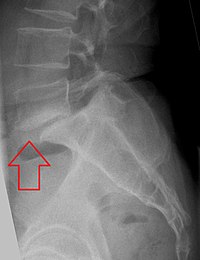
Photo from wikipedia
BACKGROUND: Lumbosacral deformities are caused by high-grade spondylolisthesis, fractures, iatrogenic flat back, and other etiologies. The S1 pedicle subtraction osteotomy (PSO) can facilitate reduction of spondylolisthesis and lower the pelvic… Click to show full abstract
BACKGROUND: Lumbosacral deformities are caused by high-grade spondylolisthesis, fractures, iatrogenic flat back, and other etiologies. The S1 pedicle subtraction osteotomy (PSO) can facilitate reduction of spondylolisthesis and lower the pelvic incidence. There are limited reports on the indications and outcomes of this technique. OBJECTIVE: To present a technical description and literature review of the S1 PSO with video summary. METHODS: This was a retrospective review of a single case to highlight the use of S1 PSO for the treatment of high-grade spondylolisthesis. A literature review was performed in accordance with STROBE guidelines. RESULTS: A 47-year-old woman presented with back and right leg pain related to grade 4 spondylolisthesis at L5-S1 with sagittal imbalance and lumbosacral kyphosis. She was taken for an L2-pelvis instrumented fusion with S1 PSO. Three days later, she was taken for an L4-5 and L5-S1 anterior lumbar interbody fusion with the L5-S1 segmental plate. Her postoperative course was notable for right foot drop that resolved in 6 weeks. Postoperative x-rays showed successful reduction of spondylolisthesis with normal alignment and sagittal balance. Based on 6 studies involving 22 true sacral PSOs in the literature, the procedure carries a 27% risk of neurological deficit, typically in the form of L5 palsy. CONCLUSION: The S1 PSO is a technically challenging operation that has a unique role in the treatment of high-grade spondylolisthesis. It carries a significant risk of L5 palsy and should be reserved for surgeons with experience performing complex 3-column osteotomies.
Journal Title: Operative Neurosurgery
Year Published: 2022
Link to full text (if available)
Share on Social Media: Sign Up to like & get
recommendations!